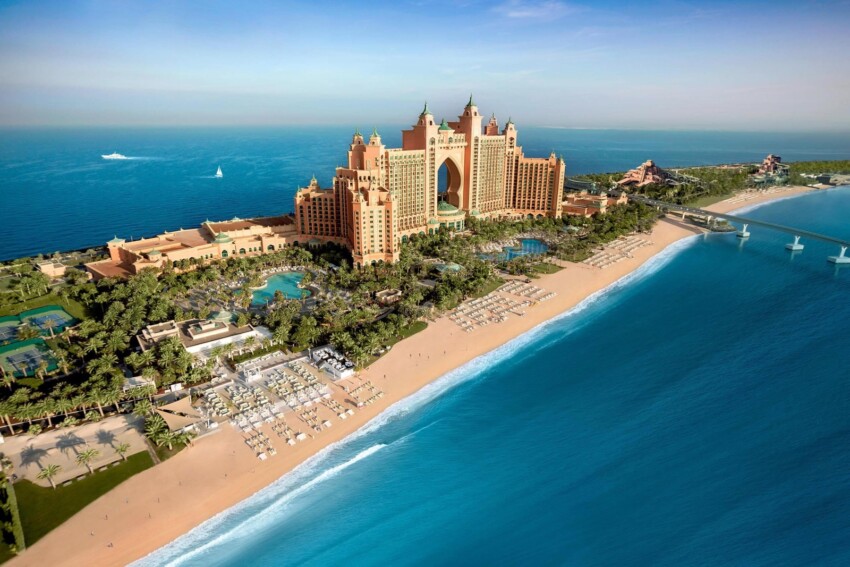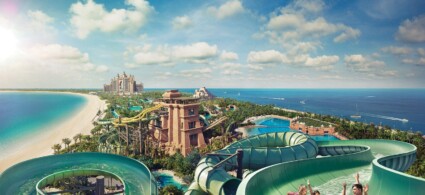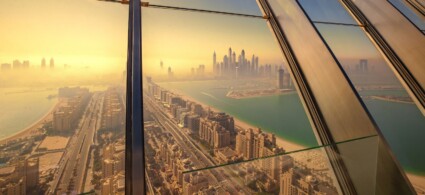

When one thinks of Dubai and its wonders, three things come to mind: the Burj Al Arab, the Burj Khalifa and the artificial island of Palm Jumeirah, a marvel of engineering and one of the city’s most incredible sights.
It is an artificial island in the shape of a palm tree, created using the technique of reclaiming land from the sea. The company behind the project is Nakheel, one of the most important builders in the Middle East.
It was the first of the three palm-shaped islands that were to adorn Dubai’s coastline. The other two are Palm Jebel Ali, identically shaped but much larger and still under construction, and Palm Deira, which was originally intended to be even larger than Palm Jebel Ali but which, following the financial crisis that gripped Dubai in the late 2000s, saw an abrupt halt to the project, which was then considerably downsized and converted into the Deira Islands.
Palm Jumeirah as its name suggests is located in the Jumeirah area: its construction began in June 2001 and the first residential units were completed in 2006, although the project was much discussed due to its many delays.
In October 2007 Palm Jumeirah was the largest island in the world and 75 per cent of the real estate was already ready, 500 families were already living there and two years later 28 luxury hotels of the major international chains such as Kempinski, Fairmont and Sofitel were already open, as well as head-turning hotels such as the Atlantis, the Oceana Residence, the Waldorf Astoria or the Kingdom of Sheba.

The undisputed icon of Palm Jumeirah is the Atlantis Hotel, built on top of it and accessible by car or by a ride on the Dubai Monorail, the scenic monorail that runs the length of the palm tree trunk.
It is a luxury hotel with a truly magnificent design, with a huge Arabian arch in the centre that gives the impression of a hole in the middle. The hotel has its own private beach and all the amenities, and is certainly worth a visit just from the outside.
Another attraction in Palm Jumeirah is Aquaventure, a water park built right next to the Atlantis hotel, also accessible via the Dubai Monorail. There are numerous attractions for young and old, several swimming pools and water games and a fully equipped beach.
Also, to admire the whole of Palm Jumeirah from above, be sure to climb up to the Palm Tower observatory, the famous The View at the Palm.
The fronds of Palm Jumeirah, on the other hand, are private: numerous multi-million euro villas are built there, each of which has one facing the street (with a garden) and one facing its own private beach. Speaking of beaches, unless you stay in one of the hotels in the area, it is impossible for normal visitors to access the beaches. Palm Jumeirah is therefore an attraction practically reserved for its inhabitants, whether permanent or temporary.
The outer reef, in the shape of a semicircle and named The Crescent, was designed to be uninterrupted, but by doing so, it prevented the natural movement of the tides, making the water stagnate within the island’s foliage. This problem was solved by adding some breaks to the barrier, so that the water could flow inwards to allow the water to oxygenate.
In 2009, it was discovered that Palm Jumeirah was sinking: currently, studies by geologists have revealed a decrease in elevation of 5 millimetres per year, but this figure could increase rapidly. This figure was categorically denied by Nakheel, which countered the accusation by stating that NASA satellites are only able to measure changes of 50 millimetres.
To see all the facilities and book accommodation in Palm Jumeirah use the form below, entering the dates of your stay.
City Card allow you to save on public transport and / or on the entrances to the main tourist attractions.




